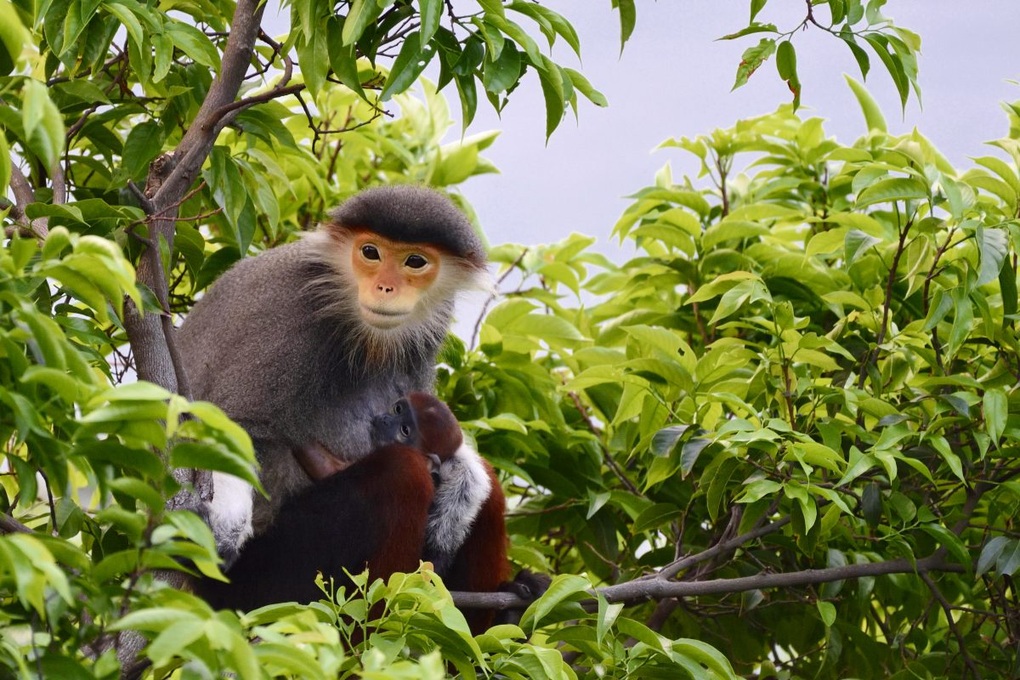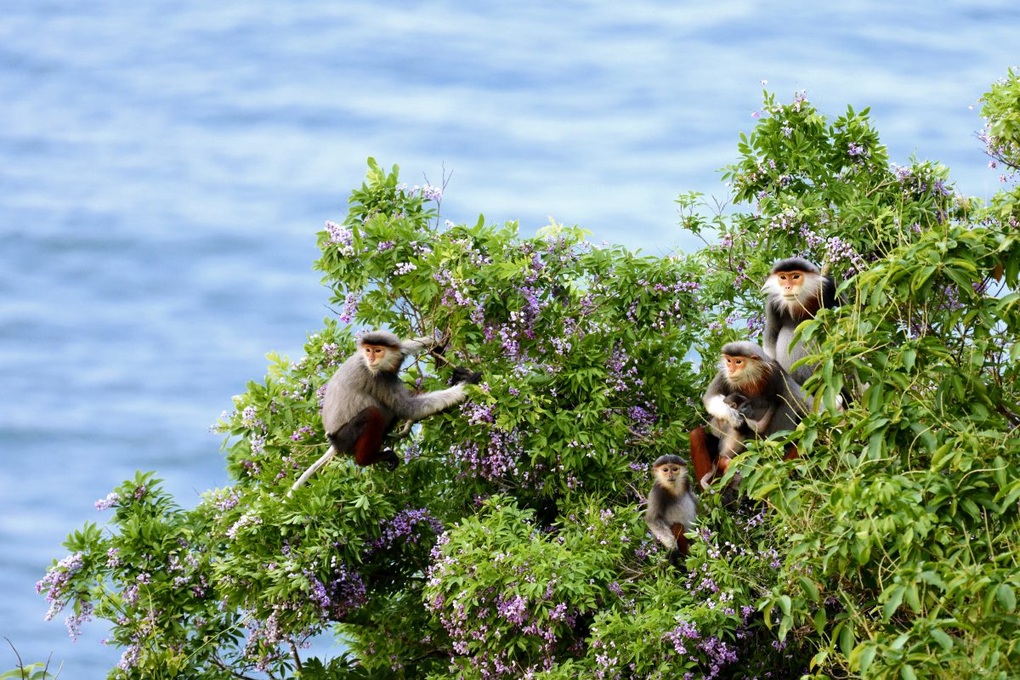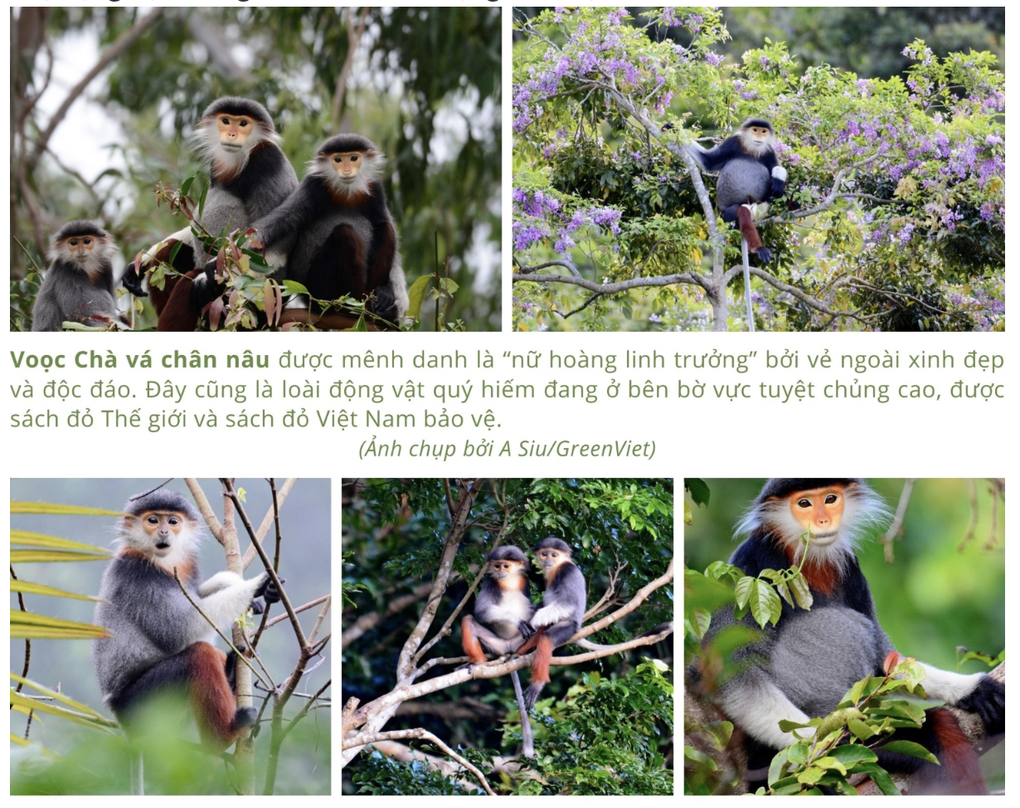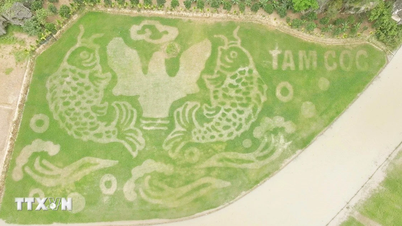(Dan Tri) - Spending only 2 hours practicing the red-shanked douc langur dance, the female student "caused a fever" on social networks when the dance clip attracted more than 1.2 million views.

The red-shanked douc langur is known as the queen of primates because of its beauty and uniqueness (Photo: Bui Van Tuan/GreenViet).
2 hours and million view clip
"The dance of the red -shanked douc langur " performed by Nguyen Thi Kim Cuc - a third-year student of the Chemistry Department, University of Education, University of Da Nang - has attracted the attention of the online community because of its uniqueness, authenticity, and positive energy.
The video is nearly 2 minutes long, simulating the movements of the red-shanked douc langur , such as: running, climbing, swinging, foraging, walking, exercising, playing... with vibrant music.
Although not fussy about costumes, filmed in a corner of a rented room with not-so-good image quality, Kim Cuc performed realistically, cutely, quite similar to the movements of the red-shanked douc langur.
Sharing with Dan Tri reporter, Kim Cuc said she was very surprised because the video became known to everyone and received many compliments.
At first, she only thought of filming the video to respond to the "Red-shanked douc langur dance" contest organized by the University of Education - Danang University in collaboration with the Center for Biodiversity Conservation of Green Viet (GreenViet).
For the girl from Binh Dinh, the douc langur is a strange animal, having only heard of it a few times in newspapers, radio, and books, but when introduced by the school, Cuc took the time to learn more about this animal in the Red Book.
After that, the female student spent 2 hours practicing this dance.
"At first, I planned to invite more classmates to perform it to make it more lively, but everyone went home for the September 2nd holiday, so I filmed it by myself. I spent 2 hours practicing the above exercise and filmed it while practicing. After that, I chose the dance part that I liked best," Cuc shared.

Kim Cuc wants to spread the message of environmental protection and wildlife conservation to more young people and the community (Photo: Character provided).
The girl added that the red-shanked douc langur dance was performed by a former student of the school. The participating students will practice based on the original clip and available background music.
"In my school, almost every class has a video of the douc langur dance to promote and mobilize the community to protect wildlife. I am very happy that the video is known by many people. I hope to spread more of the spirit of loving nature and protecting wildlife," said Kim Cuc.
Cuc said that if the video could be improved, she would like to have an additional piece of information at the end of the article about the red-shanked douc langur, to help people gain more knowledge and raise their spirit of protecting them.
Spread the message of wildlife protection
MSc. Nguyen Vinh San - Head of Student Affairs Department, University of Education, University of Danang - said that the school organized this contest with the hope of contributing a little to wildlife conservation activities and bringing the image of Da Nang's red-shanked douc langur to a wide range of students and society.

The red-shanked douc langur is classified as Endangered in the Vietnam Red Book and the IUCN Red Book, living only in the Indochina region (Photo: Bui Van Tuan/GreenViet).
This dance also originated from the collaboration between the Faculty of Art Education and the Green Viet organization. The organizers wanted to continue developing the idea from a lesson into a more complete product that has an impact on society.
"The organizers aim to convey messages about environmental protection and wildlife conservation to educate young people and society at large. In addition, the University of Education, Danang University also sends a message to society about the responsibility of a university to serve the community alongside training and scientific research activities," said Mr. San.

The red-shanked douc langur is very similar to humans, a langur family includes a father, mother, aunts and siblings (Photo: A Siu/GreendViet).
Ms. Nguyen Thi Tinh - GreenViet Center staff - shared that the life of the red-shanked douc langur in the natural green forests is very lively and innocent. They mostly live in trees, moving, foraging, and playing in the forests every day.
As a social organization operating in the field of biodiversity conservation, GreenViet hopes that the competition with joyful dances, imbued with the characteristics of the red-shanked douc langur, will contribute to spreading the images and life of this "primate queen" to the community, helping people understand more, love more and join hands to protect it.
According to GreenViet, in Son Tra peninsula, Da Nang, there is an extremely beautiful and rare primate species. That is the red-shanked douc langur, known as the "queen of primates".
They have many other names. In addition to the name of the red-shanked douc langur, they are also called: five-colored langur, soldier monkey, pope monkey, head-hiding monkey,...
This is a rare and endangered primate species in Vietnam. In Son Tra Peninsula, Da Nang, there are currently more than 1,300 red-shanked douc langurs living in the wild.
Son Tra is the place in the world where you can observe the daily habits of the red-shanked douc langur with the naked eye most easily.
The red-shanked douc langur is very similar to humans. A family of langurs includes father, mother, aunts, brothers and sisters. These beautiful primates live mainly in trees, are good at climbing and moving in the forest canopy. They have the ability to jump up to 6m.
The brown-shanked douc is a group of monkeys that eat leaves and foods rich in fiber such as green fruits, flowers, tree bark, etc. Their favorite foods are acacia leaves, figs, and chestnuts.
When young, the brown-shanked douc langurs are orange-yellow. Only when they are 2 years old do they "bloom" and take on colorful colors including black, gray, white, reddish brown, and orange.
That is why they are called the queen of primates because of their beauty.
The red-shanked douc langur is classified as Endangered in the Vietnam Red Book and the IUCN World Red Book, living only in the Indochina region.
According to the latest research by GreenViet, Son Tra is home to more than 1,300 red-shanked douc langurs. This is the largest and most sustainable population of the species today.






![[Photo] Feast your eyes on images of parades and marching groups seen from above](https://vphoto.vietnam.vn/thumb/1200x675/vietnam/resource/IMAGE/2025/4/30/3525302266124e69819126aa93c41092)
![[Photo] Fireworks light up the sky of Ho Chi Minh City 50 years after Liberation Day](https://vphoto.vietnam.vn/thumb/1200x675/vietnam/resource/IMAGE/2025/4/30/8efd6e5cb4e147b4897305b65eb00c6f)

























































































Comment (0)